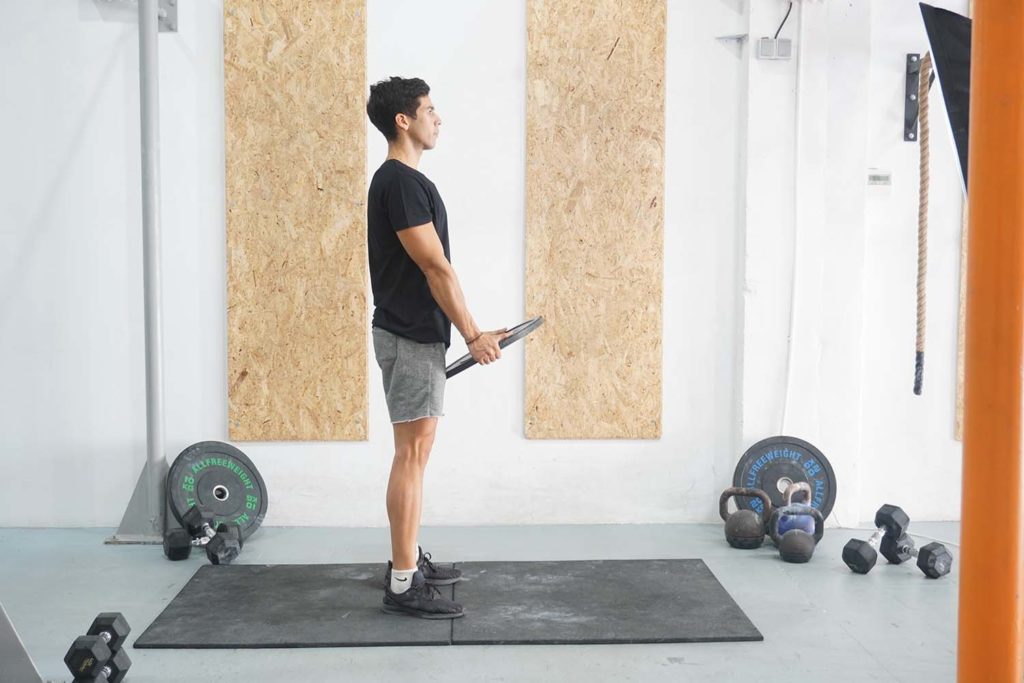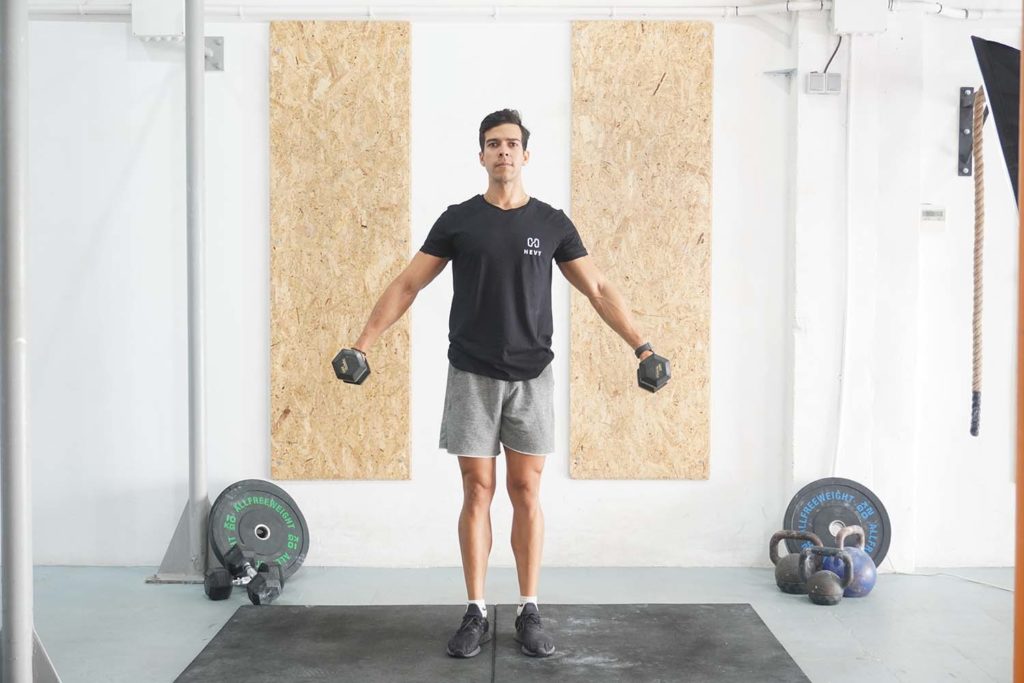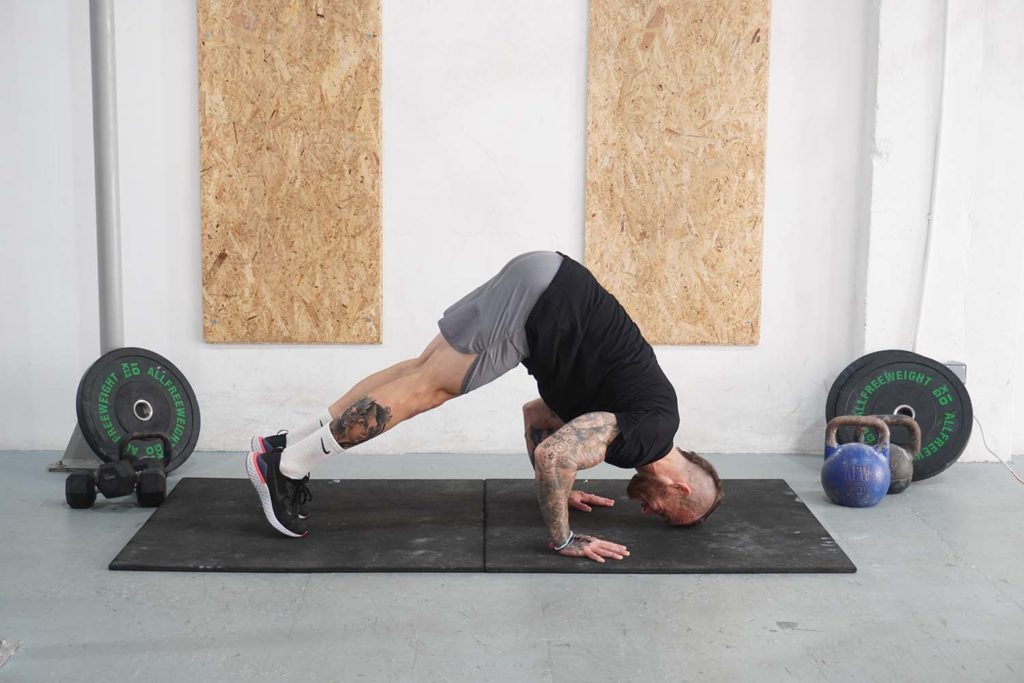Benefits of the Plate Front Raise
Having a pair of strong shoulders is a blessing. While small, our shoulders play an integral role in many everyday and athletic activities. Most notably, our shoulders allow us to raise our arms, press and lift objects above our head (1). Strong shoulders also contribute to joint stability and reduce the risk of injuries.
Plate front raises are one of the simplest and most effective movements you can do to strengthen your deltoids. The goal with the movement is to grab a weight plate, stand tall, and repeatedly raise it in front of your body. In doing so, your shoulders have to work hard and get stronger.
The plate front raise is also great because it reinforces core stability and offers a good overloading potential. You can start with a light plate and gradually increase the load as your shoulders get stronger.
We recommend including the plate front raise later in your workout, seeing as the movement isolates your shoulders.
How to do a Plate Front Raise
- Grab a plate that is light enough for you to do at least ten smooth repetitions.
- Position your hands at two opposite sides of the plate with your arms straight and to your sides.
- Bring your shoulders back, position your feet at roughly hip-width level, direct your gaze forward, and take a breath.
- Engage your shoulders and chest muscles to lift the plate in front of you as you keep your arms straight.
- Lift the plate until your arms become parallel with the floor and hold for a moment.
- As you exhale, slowly bring the plate back to the starting position where it rests lightly against your upper thighs. Keep your arms unbent throughout the entire repetition.
- Take another breath and repeat the motion.
What muscles does plate front raise activate?
The primary muscles involved in the plate front raise are our shoulders (deltoids). Our deltoids serve many functions, one being shoulder flexion (raising our arms forward), which occurs during plate front raises. The movement primarily trains the front shoulder head, but it also works the middle deltoid area (2).

Plate front raises also involve the serratus anterior, which causes shoulder protraction (3). Similarly, the movement works our biceps and upper chest, which contribute to shoulder flexion (2).
Our midsection musculature is also involved in plate front raises. As we lift the plate forward and away from our center of gravity, our abs, obliques, transverse abdominis, erector spinae, and glutes keep us stable.
Building the Strength to do a Plate Front Raises
The plate front raise is not a beginner movement, so it’s important to have a strong base before you start doing it. Standing shoulder presses with dumbbells and a barbell are great beginner movements. It builds your shoulder strength and reinforces core stability, essential in front raises. Plus, you can start with light weights and gradually increase the resistance in the upcoming months.
Lateral raises are also beneficial because you can start with the lightest dumbbells to isolate your shoulders and make them stronger. Aside from that, general training will also build the necessary shoulder strength for effective plate raises. Movements like the bench press, push-up, upright row, and shrug are highly beneficial and contribute to deltoid strength and stability.
Once you feel ready, begin with a lighter plate, focus on smooth execution, and train with a full range of motion. You should be able to do at least 12 to 15 good repetitions with a plate before increasing the load.
Variations and Modifications of the Plate Front Raise
1. Dumbbell Front Raise
A simple variation of the plate front raise is the dumbbell version. Instead of using a weight plate, grab a pair of light dumbbells and perform the same movements. Dumbbells offer the distinct advantage of forcing each deltoid to work independently, leading to more balanced development.
2. Plate Front Raise With a Pause
Adding a pause at the top of each repetition is a great way to make the movement more difficult and burn out your shoulders. Raise the plate to head level and hold it there for two to three seconds.
3. Plate Front Raise With a Twist
A neat way to make the movement more challenging without using a heavier plate is to include a twist at the top of each repetition. For example, raise the plate to head level, but instead of lowering it, twist the plate clockwise. On your next repetition, lift the plate, and turn it counter-clockwise.
Mistakes to Avoid
The most common mistake with plate front raises is using too much weight. As a result, trainees resort to swinging and momentum to lift the plate. Doing so isn’t ideal because it takes the tension away from the deltoids, forcing larger muscle groups to take control and do more of the work. Instead, you should pick a weight plate you can comfortably lift for at least 12 smooth repetitions.
Another common mistake with plate front raises is shrugging your shoulders at the top position. For example, a trainee would raise the plate to head level but elevate their shoulders as the weight travels up. Avoid the mistake because shrugging creates tension in your trapezius, and our goal is to isolate the deltoids. Keep your shoulders down and back throughout each set.
The third common mistake with plate front raises is shortening the range of motion. Many trainees lift the plate halfway up, lower it to their hips, and repeat. Doing so isn’t ideal because it prevents full deltoid activation on every repetition. Instead, you should raise the plate to head level and lower it to your upper thighs.
Similar Exercises to the Plate Front Raise
Standing Military Press (Barbell)
The standing military barbell press is an excellent compound exercise that trains your entire body and develops pushing strength. To do this movement, you have to grab a barbell, brace your body, and press it above your head. In doing so, you emphasize your deltoids and work your upper chest, triceps, upper back, and midsection muscles (4).
Lateral Raise (Dumbbell)

Dumbbell lateral raises are a simple and effective exercise to emphasize the middle portion of your deltoids (2). The goal is to grab a dumbbell and raise it to your side, forcing the medial deltoid to do all the work.
Pike Push-Up

Pike push-ups are an effective bodyweight exercise you can do for shoulder growth, especially when you don’t have any equipment around. You have to elevate your feet on a chair, gym bench, or similar. From the position, plant your hands into the floor, straighten your back, and begin doing push-ups.
